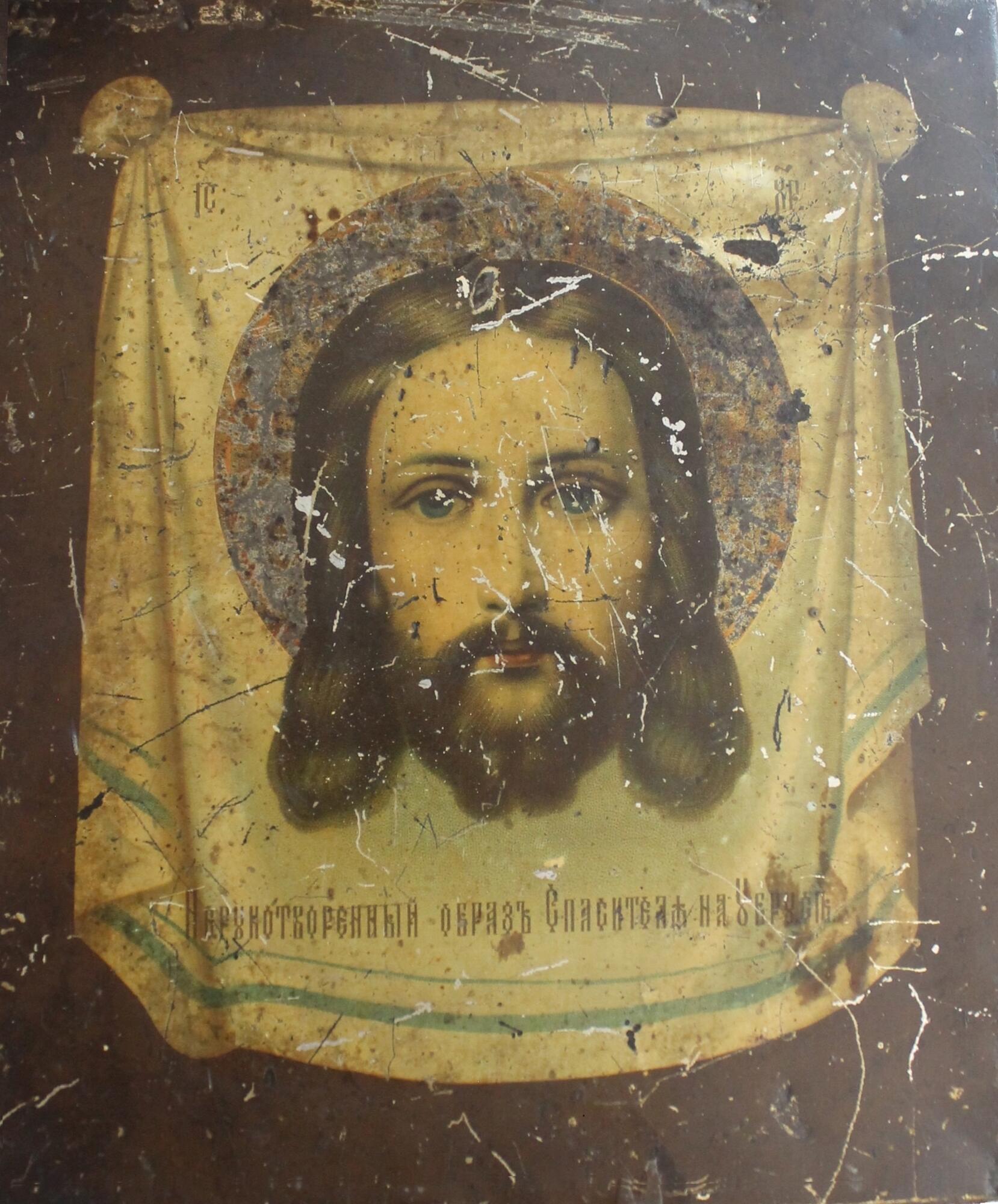The Icon of the Savior, Image Not-Made-By-Human-Hands (The Mandylion of Edessa) was made in the late 1890s in Moscow by the V.V. Bonaker Joint Stock Company. Bonaker’s factory was owned by foreign investors and was one of the most famous manufacturers of tin products in Russia. Founded in 1890, the company was engaged in the production of icons made of tin. The best masters of Moscow and Palekh were invited to create holy images. At the beginning of the 20th century, the company actually had a monopoly on the production of tin icons, but after the revolution of 1917, the production of tin icons ceased.
The Image Not-Made-By-Human-Hands was traditionally considered evidence of the Incarnation of God. Such an icon was understood as an image that miraculously appeared without the participation of the artist, that is, created by God himself. The story of the origin of the Christ’s Image Not-Made-By-Human-Hands is contained in the ‘Ecclesiastical History’ by Evagrius Scholasticus written in the 6th century. According to an Eastern legend from the early 3rd century, the sick king of Edessa, Abgar, sent his servant with a letter to Jesus Christ, thus inviting the Savior to come and heal him. He also commissioned him to paint the face of Christ. The messenger of the king tried to fulfill the request, but could not do it because of the radiance coming from the face. Then having washed himself, Christ wiped his face with a handkerchief (ubrus), on which his image was miraculously imprinted. The veil brought to Edessa proved miraculous, and king Abgar was healed, and his subjects converted to Christianity. The letter of Christ to Abgar and the uncreated image were preserved in Edessa as relics.
Since the 12th century, the Image of the Savior Not-Made-By-Human-Hands has been widely used mainly in temple paintings. According to certain sources, icons of the Savior, Image Not-Made-By-Human-Hands, came to Ancient Rus in the 9th century. There are several iconographic types of the image Not-Made-By-Human-Hands: ‘The Mandylion of Edessa’, where the face of Christ is placed on the image of a board (ubrus) of a light shade, and ‘Vernicle’, where the word ‘vernicle’ means tile or brick. According to legend, the image of Christ appeared on the tiles or bricks that hid the niche with the Icon of the Savior, Image Not-Made-By-Human-Hands. Occasionally, this type of icon has an image of brick or tile masonry as the background, but more often the background is colored dark compared to the ubrus.
The Image Not-Made-By-Human-Hands was traditionally considered evidence of the Incarnation of God. Such an icon was understood as an image that miraculously appeared without the participation of the artist, that is, created by God himself. The story of the origin of the Christ’s Image Not-Made-By-Human-Hands is contained in the ‘Ecclesiastical History’ by Evagrius Scholasticus written in the 6th century. According to an Eastern legend from the early 3rd century, the sick king of Edessa, Abgar, sent his servant with a letter to Jesus Christ, thus inviting the Savior to come and heal him. He also commissioned him to paint the face of Christ. The messenger of the king tried to fulfill the request, but could not do it because of the radiance coming from the face. Then having washed himself, Christ wiped his face with a handkerchief (ubrus), on which his image was miraculously imprinted. The veil brought to Edessa proved miraculous, and king Abgar was healed, and his subjects converted to Christianity. The letter of Christ to Abgar and the uncreated image were preserved in Edessa as relics.
Since the 12th century, the Image of the Savior Not-Made-By-Human-Hands has been widely used mainly in temple paintings. According to certain sources, icons of the Savior, Image Not-Made-By-Human-Hands, came to Ancient Rus in the 9th century. There are several iconographic types of the image Not-Made-By-Human-Hands: ‘The Mandylion of Edessa’, where the face of Christ is placed on the image of a board (ubrus) of a light shade, and ‘Vernicle’, where the word ‘vernicle’ means tile or brick. According to legend, the image of Christ appeared on the tiles or bricks that hid the niche with the Icon of the Savior, Image Not-Made-By-Human-Hands. Occasionally, this type of icon has an image of brick or tile masonry as the background, but more often the background is colored dark compared to the ubrus.



